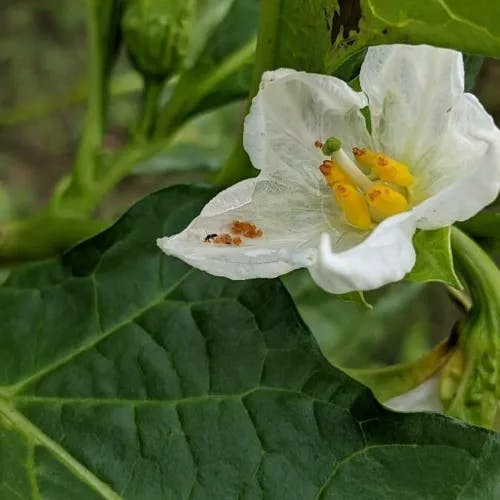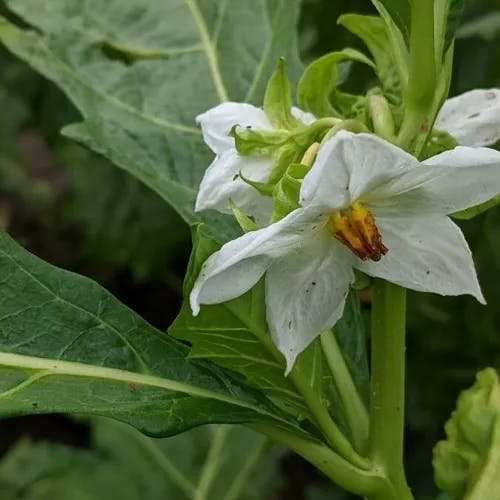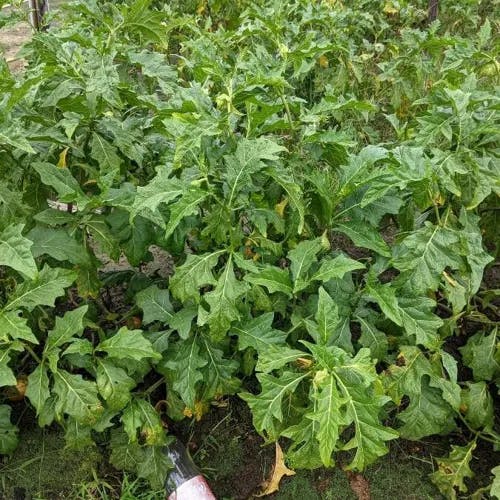The perennial herbaceous vine, called the African eggplant's scientific name: Solanum macrocarpon, belongs to the nightshade family. This West African native plant has lobed green leaves covered in hairs and grows up to two meters tall. Its star-shaped flowers come in white, purple and yellow shades depending on the cultivar. Ranging up to twenty centimeters long when mature, the elongated berry fruit transforms from green to orange or yellow when ripe. Valuable for its rich flavor, culinary dishes commonly include the African eggplant. With proper drainage and sunlight, it grows well in tropical and subtropical areas, tolerating varying temperatures. The nutritional content and resilience of the African eggplant make it an important crop.
African eggplant
- Scientific name
- Solanum macrocarpon
Basic Information
- Solanaceae Family Solanum Genus African eggplant Species
- Solanaceae > Solanum > Solanum macrocarpon
- 83%
- The Completeness of This Encyclopedia
Please help us complete the encyclopedia, Terrarium is a encyclopedia service to be completed with everyone in the world. Currently, this page is 83% complete. For more information on how to contribute, please click here.
- Flower
- Forb/herb
- Fruit
- Perennial
- Shrub
- Vegetable
- Height
- 100cm ~ 150cm
- Flower Color
- Leaf Color
- Anthesis
- summer
- Sunlight Exposure
Full Sun Long hours of sunlight from morning to afternoon Partial Shade A location in the shade of a tree or where either the morning or afternoon is shaded Full Shade A place where there is no direct sunlight
- Full Sun
- Hardiness Zones
This is an indicator to know to which zone each plant can winter. Knowing the zone of each plant gives you an idea of the cold temperature resistance when grown in the ground without a roof. 2: -42.7 to -40.0 3: -39.9 to -34.4 4: -34.3 to -28.9 5: -28.8 to -23.3 6: -23.2 to -17.8 7: -17.7 to -12.2 8: -12.1 to -6.7 9: -6.6 to -1.1 10: -1.0 to 4.4 11: 4.5 to 10.0
- 10
- Cold resistance
- Poor
- Heat resistance
- Good
- Habitat of origin
- Africa
- Growth Rate
- Normal
What is African eggplant (Solanum macrocarpon)?
What is African eggplant (Solanum macrocarpon)
Flower meaning
The American flower language, the African eggplant plant is associated with: Strength. Resilience. Endurance. An example is Strength, symbolizing withstanding challenges, like the eggplant thriving in conditions. Birth flowers are by month and date only.
0
0
Calendar of African eggplant (Solanum macrocarpon)
Calendar
African eggplant in the United States blooms during summer, June to August. Flowers best in July, vibrant colors, full bloom. Blooming lasts 4 to 6 weeks, depending on environment and care. To encourage longer blooming, ensure adequate sunlight, water, well-draining soil. Removing faded flowers also promotes continuous blooming. Regular fertilization with balanced fertilizer supports healthy flowers. Monitor plant for pests, diseases that hinder blooming.
0
0
How to grow African eggplant (Solanum macrocarpon)
Watering
For African eggplants, every 5 to 7 days, watering frequency should be moderate. Consistently moist, however, not waterlogged. Humidity level is around 60 to 70% during growing season. During dormant period, watering reduce to every 10 to 14 days preventing root rot. Water deeply, allowing soil dry slightly between waterings promoting healthy root development. Adjust watering based on environmental conditions such as temperature and humidity preventing over or under-watering.
0
0
Soil and Fertilizer
African eggplant grows well in loose soil with a pH of 6 to 6.8. It needs fertile, organic-rich dirt for best growth. Fertilizers high in potassium and phosphorus help the plant. Use a 10-10-10 fertilizer before planting and when flowering starts. Fertilize every 4 to 6 weeks during growth. Do not over-fertilize or can cause problems. Keep an eye on the plant's growth. Change the fertilizer to match. Check the soil often. Ensure it stays loose and airy. Good soil and fertilizer helps the plant grow strong. It also helps produce lots of fruit.
0
0
Sunlight and Place
African eggplants thrive in full sun exposure, requiring at least 6 to 8 hours of direct sunlight daily. During the summer, they exhibit excellent heat tolerance, preferring temperatures between 70 to 85°F (21 to 29°C) during the day and slightly cooler temperatures at night. These plants need adequate watering to prevent wilting, and in winter, reduce watering frequency to avoid waterlogged soil. To ensure optimal growth, place them in well-draining soil in a location sheltered from strong winds. They benefit from consistent sunlight throughout the day. For optimal growth, place African eggplants in well-draining soil in a location sheltered from strong winds. They benefit from consistent sunlight throughout the day, making them ideal for sunny spots in the garden or on a sunny windowsill.
0
0
Advanced Information of African eggplant (Solanum macrocarpon)
Pruning
African eggplant needs regular pruning to help it grow well and make more fruit. Pruning is needed to get rid of dead or sick branches, let more air move around the plant, and shape the plant to look nicer. Pruning should happen in late winter or early spring, before new growth starts. Use clean, sharp pruning shears to make clean cuts just above a leaf node or side branch. After pruning, add a balanced fertilizer to help new growth happen and water the plant really well. Observe the plant closely for any signs of pests or diseases, and remove any affected parts right away to stop them from spreading more. Pruning and cutting back the plant will help the plant stay productive and healthy.
0
0
Planting and Harvest
The tropical plant Solanum aethiopicum, commonly named African eggplant, can flourish when cultivated in containers or directly in the ground. For growing African eggplant in pots, select a container with sufficient drainage openings to prevent waterlogging of roots. Partially pack the pot with a porous, fast-draining potting mixture, retaining area for the plant's root system. Carefully detach the plant from the nursery pot and situate it in the new container, confirming the top of the root ball is level with the soil. Gently return soil around the plant to fill the pot. After potting, thoroughly hydrate the plant and situate it in a spot with ample, indirect sunlight. If repotting becomes necessary once the plant outgrows its existing container or the soil becomes too compressed, choose a somewhat larger pot and repeat the same potting procedure. Inadequate care can hinder growth and health of African eggplant. Sufficient water is important, but overwatering can cause root rot. Apply a balanced fertilizer regularly to encourage healthy growth. Pruning any dead or damaged foliage keeps the plant's appearance tidy. Check for pests and diseases, and use appropriate control measures if needed. With proper care, African eggplant can prosper in a pot or planted in the ground.
Propagation
The african eggplant, also known by Bitterball and Gboma, possesses wide-ranging propagation practices encompassing sowing fertilized ovules, bifurcating, grafting, and foliar grafts. To increase numbers by sowing seeds, assemble fully developed eggplants and extract the seeds within. Deposit the seeds in an adequately draining soil mixture, lightly covering with topsoil. Maintain dampness and situate the container in a bright and warm locale. For bifurcating, meticulously divide the organism into smaller divisions, guaranteeing each section retains roots. Embed the divisions in separate containers or directly underground, furnishing adequate hydration and sunlight. To propagate through grafting, excerpt stem grafts from vigorous plants, ensuring at minimum two nodes are present. Remove lower leaves and dip the severed end in a rooting catalyst. Embed the grafts in an adequately draining soil mixture and retain in a warm and humid climate until roots mature. Foliar grafts can also propagate. Excerpt a vigorous leaf and slice into sections, guaranteeing each section retains a vein. Embed the leaf sections in an adequately draining soil mixture, maintaining dampness and a warm locale. Reap the fruits when completely matured and attained desired magnitude and pigment.
Pests and Diseases
The African eggplant, known as Solanum aethiopicum, encounters various insects and diseases. The fruit borer worm tunnels inside the fruit, causing wilting. Aphids feed on the sap, stunting growth. Bacterial wilt makes leaves yellow and kills the plant. Powdery white mildew coats leaves. Early blight creates dark lesions. Monitoring helps detect pests early. Remove and destroy infested plants. Introduce ladybugs to eat aphids. Use insecticidal soap sprays. Rotate crops and sanitize tools to prevent bacterial wilt spread. Space plants to discourage fungal diseases. Apply fungicides as needed. The African eggplant requires vigilance to maintain health.
Habitat of African eggplant (Solanum macrocarpon)
Habitat
Toxicity of African eggplant (Solanum macrocarpon)
Health Benefits
- edible
- edible
- Toxic
- No toxicity
NO DATA
Toxic for dogs and cats
NO DATA
Q&A of African eggplant (Solanum macrocarpon)
- What Are the Benefits of African Eggplant?
The indigenous African crop Solanum macrocarpon, known locally as gboma eggplant, possesses many supportive nutrients. Its modest leaves furnish an abundance of antioxidants and nutrients inclusive of vitamins B and C moreover to potassium and calcium. Regular consumption of gboma contributes to digestive and heart health. Its rich fiber relaxes digestion while the vitamins and minerals nourish circulatory wellbeing. Though further research is necessitated, primary indications intimate the eggplant may assist regulate blood sugar. By furnishing an array of protective nutrients and antioxidants, gboma eggplant promotes general health.
0
0
- How do I properly harvest and store African eggplant seeds for future planting?
To properly harvest and store Solanum macrocarpon, or African eggplant seeds, you should wait until the fruit is fully mature and begins to soften. At this stage, the seeds inside are fully developed and ready for harvest. After harvesting the seeds, carefully clean them and let them dry on absorbent paper for a few days. Make sure the seeds are completely dry before storing them in an airtight container in a cool, dark place. Proper storage will help maintain the seeds' viability. When sowing African eggplant seeds, prepare the soil by mixing in organic matter. Sow the seeds 1 cm deep, water gently and maintain even moisture. Thin seedlings to 60 cm apart. Support the developing plants with stakes. Harvest eggplant fruits while still glossy. For best results, propagate African eggplants from fresh seeds each season.
- Is there a recommended way to choose Solanum macrocarpon?
The versatile African eggplant, with the scientific name Solanum aethiopicum, has numerous varieties to select from when buying seeds or seedlings. One well-known variety is the elongated fruit of the Gilo type, which has a mild flavor. The Shum type yields round fruits with a slightly bitter taste. The Kumba variety produces small, round fruits often utilized in stews and soups. When picking seeds or seedlings, it's important to think about the desired fruit form, flavor, and planned use. Also, choosing seeds or seedlings from reputable suppliers helps guarantee quality and authenticity. Additionally, researching specific cultivation requirements for each variety aids successful growing.
0
0
- Is there a recommended way to choose?
African eggplant has various varieties such as 'Gilo' with elongated fruits, 'Igbo' with round fruits, and 'Kumba' with small, round fruits. When picking seeds, make sure they are from a trusted place to make sure of value and realness. For young plants, look for lively plants with bright green leaves and strong stems. Stay away from young plants that look droopy, stained, or have any indications of irritations or sicknesses.
- How to Identify and Care for African Eggplant Leaves?
African eggplant, with the scientific name Solanum macrocarpon, possesses leaves that are sizable, segmented, and have a glossy green coloration, frequently exhibiting a somewhat undulating border. The leaves are commonly 10-20 centimeters in length and have a coarse texture. To properly care for these plants, make certain they are cultivated in adequately drained topsoil and get adequate sunlight exposure to partial shade. Regular irrigation is vital, however take care to avoid overwatering which can result in root decay. Apply a balanced vegetable fertilizer to the plants every two weeks to encourage vigorous growth. Monitor frequently for pests and diseases, and address issues promptly to maintain the plant's wellness.
0
0
- What are the culinary and nutritional properties of African eggplant leaves?
African eggplant leaves, scientifically known as Solanum macrocarpon, contain vitamins A, C, and K. Also, minerals such as iron. Often utilized in African food preparation like soups and stews. Their somewhat harsh flavor provides an exclusive essence to meals. These leaves have antioxidants. Useful for general health. However, appropriately cook the leaves to lower the bitterness. And improve the taste.











